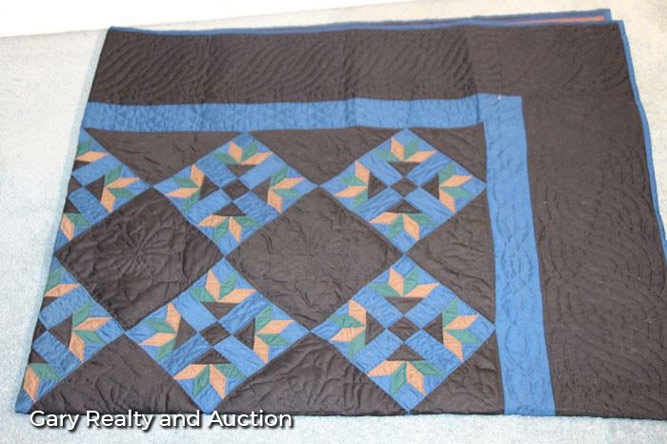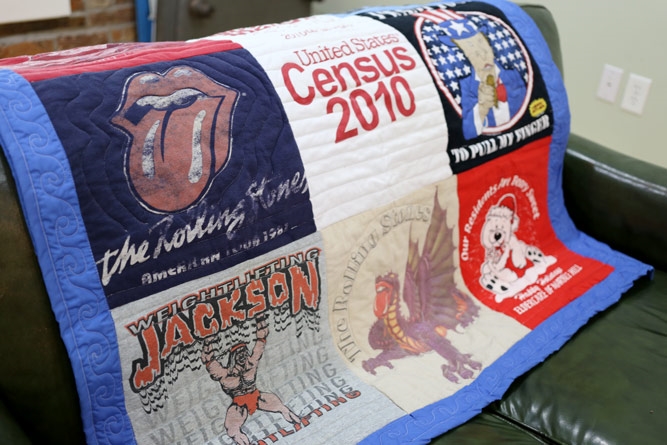Vintage Quilts

When I was a kid (and, I suspect, still) my church would raffle off a quilt every month. Tickets were $2 a piece, or 3 for $5. Every month, I would enter. After all, who can resist the siren song of gambling with someone else’s money? (Thanks, Grandma.)
Every month, I didn’t win.

But I never lost my appreciation for quilting. Not in an I-want-to-learn-how-to-do-that sort of way, though. Just in an I-want-one way.
And now I own several (#blessed).
The first quilt I acquired was one of those coveted church quilts, given to me by my grandmother as a wedding gift. A few were sewn and hand-tied by my husband’s great-grandmother. One was a memory quilt made out of my father-in-law’s t-shirts after he passed away. My most recent acquisition was one made by yet another in-law, who sews patches into the shape of an elephant or a donkey into a quilt, depending on the recipient’s political leanings.
And every time I attend an estate sale, I struggle to convince myself that I have room to add to my collection.
Quilting is beautiful in so many ways. From the history the squares contain, the togetherness the act of quilting creates—like the church ladies who gathered weekly making raffle quilts—to, of course, the final product, which can be impressive in its simplicity or its elaborate design.
So it’s no wonder that quilts are often a coveted item at estate sales. And that there are people out there like Julia Zgliniec, a quiltmaker, instructor, and appraiser, who has spent considerable time studying and appreciating the rich history of quilts. “I mainly collect quilts that have something interesting to talk about,” she said, “usually designs worth mentioning or interesting fabrics. I have examples ranging from c.1790 to contemporary.”
Knowing how to age and value vintage quilts can be a time-consuming process. Is the fabric antique, but quilted recently? A quilt has a date of 1915 embroidered into the pattern...but was it made in that year, or a few decades later? Research is needed and study is necessary before you can hope to identify these things on-sight. But that doesn’t mean you can’t get your collection started before that.
“Learning about the various colors and styles of different eras is a must,” Julia said. But when it comes to estate sale shopping, “the best thing is to just buy the quilt. It could be sold later if it was not wanted.”
The first rule of quilt buying, “is to buy the best you can afford,” Julia said. “Quilts that are more costly usually hold their value better than those that are worn, and condition is the number one factor affecting value.” Also, she added, you should buy what you like: a good rule of thumb for all your shopping decisions.
Quilt Styles
With a knowledge of age and history, you can buy according to age and history, but in the meantime, buy what you fancy. There are a wide variety of quilt styles to choose from, in any number of colors. Here are just a few:

Amish quilts
If you want to get technical, an Amish quilt is one made by Amish women. But a broader definition of this style of quilt involves the use of traditional patterns and dark, solid-colored fabric.

Cathedral Window
A more intricate quilting pattern than the traditional style. Cathedral window quilts incorporate folds and stitches to create a three-dimensional design.

Charm Quilt
A patchwork made with small, non-repeating patches.

Crazy Quilt
A quilt made of oddly-shaped patches. Embroidery, beads, and other embellishments are also often included in the crazy quilt design.

Double Wedding Ring Quilt
A popular pattern featuring interlocking rings.

Friendship Quilt
These are the yearbooks of the quilting world. Made with love, and inscribed with signatures or personal messages from the people who made it. And you thought that those friendship bracelets you made in 6th grade were something special...

Kaleidoscope Quilt
A symmetrical quilt block pattern that resembles what one might see through the eye of a kaleidoscope.

Memory Quilt
Quilts made in memory of a person or event. These quilts often utilized pieces of a person's clothing, whether it be the clothing of a person who passed away, or outgrown baby clothes fashioned into a quilt as a keepsake.

Signature Quilt
Similar to—and sometimes coinciding with—a friendship quilt, a signature quilt is simply one with individually-signed blocks.

Whole Cloth Quilt
These quilts get their design not through the use of patches, but from stitching. The quilt top is one solid sheet, and the pattern is quilted onto it.
Once you have begun your collection: what next?
Cleaning Your Quilt
When you bring a quilt home from an estate sale, it’s a good idea to clean it. But it’s important to take great care when doing so, particularly with older, more fragile quilts. Washing quilts puts them at risk. If you can get away with airing them out, or vaccuming them with a soft mesh screen or nylon over the hose attachment, or spot-cleaning them, I would recommend it.
“The best thing to do is NOT to even think about wet-cleaning a quilt until a knowledgeable person has seen it. A great deal of harm can be done,” Julia said. “Airing a recent purchase outside between sheets is safe if the quilt smells but other than that, get advice.”

She recommends reaching out to an appraiser in your area for insight when it comes to caring for your specific quilts, and the First Aid for Family Quilts by Nancy O'Bryant Puentes—a booklet she uses regularly in her classroom.
But, if you, like me, are a person who uses her quilts regularly, you’ll likely want to wash them.
Real talk: I throw mine in the washing machine, then the dryer, and then I snuggle up because nothing beats a warm, freshly-dried blanket.
But no respectable quilt-collector is going to recommend that you do that. In fact, last night I discovered a hole in my most beloved quilt. A smarter person would learn a lesson from this.
So, if you’re going to be bold and wet-wash your quilt without expert insight, be sure to hand wash it. This will allow you to control the agitation, and reduce the risk of threads coming loose or getting caught in an overzealous machine. Test it for colorfastness. Lift the wet quilt with both arms, not by a corner or side, which will put undue stress on the fabric. Lay flat to dry.
We really don’t want you to ruin your quilts, you guys.

If you’re not going to use your quilt for snugglin’, they still make a wonderful addition to a room. You can drape them over quilt racks, or even hang them as wall tapestries. The George Washington University Museum offers some suggestions for hanging textiles.
“The biggest danger to antique quilts is exposure to light,” Julia said. “Fading can greatly alter the value of an antique or vintage quilt.” She recommends displaying your quilts away from direct sunlight, rotating them occasionally so a single quilt isn’t exposed more than others. “Of course,” she adds, “this is a good reason to collect at least four.”